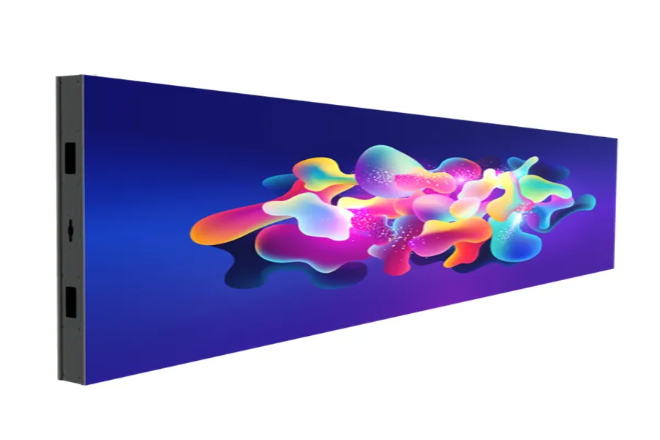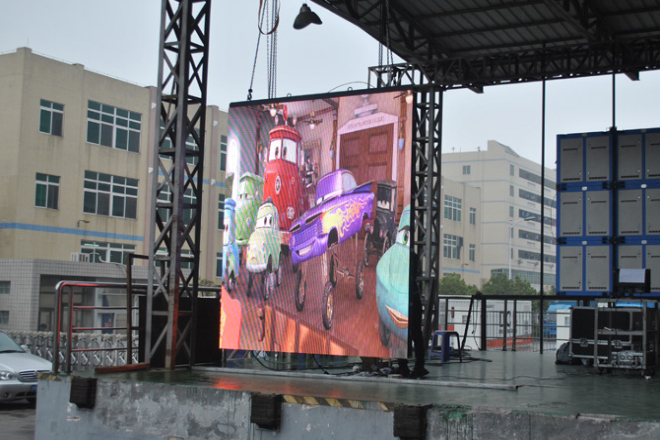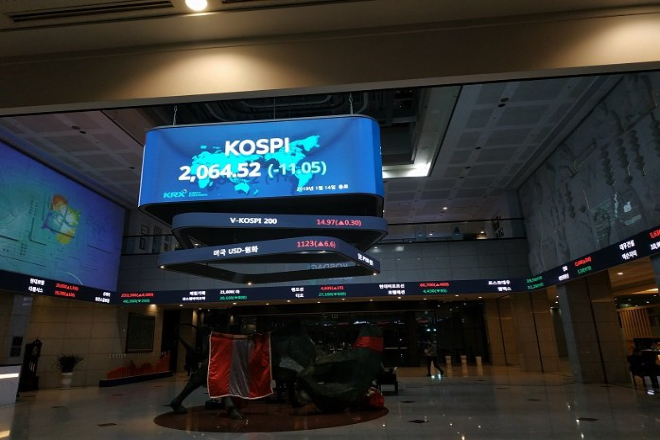Introduction

Walking in the streets and alleys now, you can see all kinds of cool Afficheurs LED everywhere, especially the thin and light ultra-thin LED screens, which make people feel full of technology.
But many people will ask: Can this ultra-thin LED display only be used indoors? Actually, it is not.
Table des matières
1. What is an ultra-thin LED display?
Imagine that there is such a display screen that is not as thick and clumsy as traditional LED displays but like a light feather, with a thickness of only a few millimeters to more than ten millimeters.
Holding it in your hand, you can hardly feel its weight, and it is also easy to install and does not take up too much space.
This is an ultra-thin LED display screen, which cleverly integrates key components such as LED lamp beads and drive circuits on an extremely thin substrate.
It’s like a bunch of scattered parts are carefully assembled into a small and exquisite whole.
Key technical features of ultra-thin LED displays
1). Lightweight design
Traditional LED displays are like a “big guy” with a thickness of dozens of millimeters. When installing, you have to consider its huge body and find a spacious enough place to place it.
But ultra-thin LED display is different. Its thickness can be so thin that you will be amazed. For example, some ultra-thin LED display screens used indoors are less than 10mm thick, which is about the same as a thin magazine.
In some places with particularly high space requirements, such as the atrium of a shopping mall, people may have been worried about the traditional display screen taking up too much space in the past.
Now, with ultra-thin LED display screens, they can be easily installed, which does not affect the overall appearance, and can display advertising information well. Moreover, it is so light that it seems to have no burden.
It does not take so much effort to transport it, and the load-bearing requirements of the installation structure are much lower during installation, which can save a lot of installation costs.
2). Highly integrated
The ultra-thin LED display screen is like a super “storage box,” which integrates components such as LED lamp beads, driver chips, and control circuits on a substrate.
This is like putting a bunch of messy things neatly in a small box. Not only does it look neat, but the connection lines and interfaces between the components are also reduced, and the stability and reliability of the system are naturally improved.
For example, some advanced ultra-thin LED displays use integrated packaging technology to package multiple LED chips in a small package, and the size of the display module is reduced at once.
In addition, it also adopts a modular design. Each display module has its own functions and interfaces, just like a piece of building blocks, which can be easily spliced and combined.
If there is a problem with a module, there is no need to repair the entire display screen. Just replace the problematic module, which is simple and quick.
3). Advanced heat dissipation technology
Although the ultra-thin LED display is as thin as a piece of paper, the LED lamp beads will heat up when it works. If the heat cannot be dissipated, the performance of the display will be affected, and the life span will be greatly reduced.
But don’t worry. The ultra-thin LED display has advanced heat dissipation technology to deal with it. It uses a lot of high thermal conductivity materials, such as graphene, which is like installing a “heat dissipation expert” for the display screen, which can quickly conduct heat away.
Moreover, heat dissipation fins are designed on the back of the display screen, just like installing a “heat dissipation wing” for the display screen, which increases the heat dissipation area and allows the heat to be dissipated into the air faster.
In this way, the display screen can always maintain a good working condition.
2. Comparison between ultra-thin LED display and ordinary LED display

In the large family of LED displays, ultra-thin LED displays and ordinary LED displays are like two brothers with different personalities, each with unique abilities and applicable scenarios.
1). Thinness:
Imagine that there are two display screens in front of you; one is as thin as a leaf, and you can hardly feel the weight in your hand; the other is like a thick wooden board, heavy.
This is the huge difference in thinness between ultra-thin LED displays and ordinary LED displays.
Ultra-thin LED display is really “thin”; the thickness may be only a few millimeters to more than ten millimeters, and the weight is also surprisingly light.
Some ultra-thin LED display screens are as thin as a credit card, and the weight may be less than half of that of ordinary display screens.
Such a thin design is very convenient to install. For example, if you use an ultra-thin LED display and want to install the display on the glass window of a shopping mall.
You can just stick it on the glass without having to build a complex steel frame structure like ordinary display screens.
Moreover, its thin and light characteristics can save a lot of space. In some places where space requirements are particularly demanding, such as elevators and narrow corridors, ultra-thin LED displays can show their talents.
Look at ordinary LED displays; the thickness and weight are like a “little fat man.” Because they need to carry heavier substrates and electronic components, ordinary LED displays are usually thicker and heavier.
When installing, not only do you have to build a steel frame, but you also have to consider the load-bearing capacity of the steel frame, so the installation cost will naturally go up.
Moreover, such a heavy display is also a hassle to transport, and you have to carry it carefully for fear of bumping it.
2). Transparency:
Transparency is like the “breathing ability” of the display. Ultra-thin LED displays are masters in this regard.
Some ultra-thin LED displays use transparent crystal film films with transparent mesh circuits etched on the surface, and then the components are attached through a vacuum sealing process.
In this way, its light transmittance can reach more than 95%. What does it mean? That is, when you stand behind the display and look at it, you can hardly feel the existence of the screen, and the light can pass through the display freely.
For example, in a sunny centre commercial, the window with an ultra-thin LED display is installed, and the goods inside can still be seen clearly without being blocked by the display.
Moreover, the image effect it presents is particularly bright and beautiful, just like putting a beautiful coat on the goods.
Ordinary LED display screens are not so “transparent.” Because they require thicker substrates and backlight sources, their transparency is greatly limited.
After installation, it is like sticking a thick film on the window, which will block part of the light and affect the indoor lighting.
In some places that need to maintain a bright environment, such as jewelry stores and museums, ordinary LED display screens are not suitable.
3). Flexibility:
Flexibility is like the “transformation ability” of the display screen. Ultra-thin LED display screens are simply a “Transformer” in this regard.
It can support arbitrary cutting without being restricted by size and shape. You can cut it into a circle, triangle, or other strange shapes, no problem.
For example, in a stage performance, the designer wants a curved display screen to create a dreamy effect, which can be easily achieved with an ultra-thin LED display screen.
It can perfectly fit various complex shapes of installation surfaces, just like putting on a customized gorgeous coat for the stage.
Moreover, this flexibility also gives ultra-thin LED displays a wide range of applications in architectural design, vehicle-mounted displays, and other fields.
Imagine that in the future, ultra-thin LED displays may be installed on the glass of cars to display navigation information, vehicle speed, and other content. How cool would that be!
Ordinary LED displays are more “regular”. Its size is fixed, and it often needs to be spliced to achieve a large-area display.
When splicing, not only the splicing gap must be considered, but also the color and luminosité between each display must be consistent, which is a technical job.
Moreover, the spliced display screen is relatively simple in shape, and it is difficult to make some unique shapes.
On some occasions, when the display effect and shape are relatively high, ordinary LED displays seem a bit powerless.
4). Installation and maintenance:
Installation and maintenance are like the “logistics support” of the display screen. Ultra-thin LED displays save a lot of worry in this regard.
When installed, it can be directly attached to the glass surface without the need for additional steel frame support.
Just connect the power supply and signal, and it can be used normally. Moreover, the vacuum sealing process it adopts also ensures the stability and durability of the components inside the screen.
Even if there is a problem during use, it is relatively convenient to maintain. For example, if a component is broken, you only need to remove it and replace it, and there is no need to carry out large-scale repairs on the entire display.
The installation of ordinary LED display screens is not that simple. It requires the construction of a steel frame structure, which is not only time-consuming and labor-intensive but may also damage the original structure of the building.
During the installation process, precise debugging is also required to ensure that the display effects between each display screen are consistent.
Moreover, in terms of maintenance, ordinary LED display screens often require the replacement of the entire module, which is relatively costly.
For example, if a display screen fails, the entire module may need to be removed and sent to the manufacturer for repair, which not only delays time but also costs a lot of repair costs.
5). Display effect:
The display effect is like the “face value” of the display screen. Ultra-thin LED display screens have unique charm in this regard.
It has the characteristics of high luminosité, wide angle de vue, and dazzling colors. In direct sunlight, the ultra-thin LED display can still display the content clearly without reflection or unclear viewing.
Moreover, its wide viewing angle makes the picture quality still excellent when viewed from different angles. For example, in a large outdoor square, an ultra-thin LED display is installed, and no matter where the audience stands, they can see clear and gorgeous pictures.
In terms of display color, the ultra-thin LED display is also very rich and can present realistic image effects, just like showing a beautiful picture directly in front of the audience.
The display effect of an ordinary LED display is also good, but it may not be as good as an ultra-thin LED display in terms of brightness, contrast, and color saturation. In some environments with strong light, ordinary LED displays may appear blurred and dim.
Moreover, its viewing angle is relatively narrow. If the audience deviates from the best viewing angle, the picture quality will be significantly reduced.
3. Can ultra-thin LED displays be used outdoors?
Ultra-thin LED display can be used outdoors. In fact, with the advancement of technology, ultra-thin LED display has shown strong adaptability and advantages in outdoor applications.
1). Adaptability in outdoor applications
1.1). High brightness:
The light outdoors is so bright that it is blinding. If the display is not bright enough, you can’t see what is displayed on it in broad daylight. The ultra-thin LED display is amazing in this regard!
It is like a guy with a built-in “strong flashlight” and has super high brightness. Even in the middle of the day, when the sun is shining brightly, it can still display the picture clearly.
For example, in some outdoor stadiums, when there are so many spectators and direct sunlight during the game, the ultra-thin LED display can clearly display the score of the game, the information of the athletes, etc., and the audience can see it clearly no matter where they sit.
1.2). Waterproof and dustproof:
The outdoor environment is so complicated; it rains and blows, and dust is everywhere. If the display is not waterproof and dustproof, it will break down in a short time.
An ultra-thin LED display is like wearing a layer of “protective armor” with super waterproof and dustproof capabilities. It can generally reach an IP65 level of protection.
What does this mean?
It means that ordinary rain and dust can’t get into the screen at all. Just like in some seaside squares, there is often sea breeze, and it rains from time to time, the ultra-thin LED display can work steadily there and will not be affected by this bad weather.
1.3). Durability:
The outdoor temperature changes greatly; it is as hot as a steamer in summer and as cold as an ice cellar in winter, and the humidity is also different. Ordinary things may break down quickly in such an environment, but the ultra-thin LED display is different.
It is like a “cockroach” and is particularly durable. It uses high-quality materials and advanced manufacturing technology.
Even if it works continuously for several days at high temperatures or freezes for a long time in the cold winter, it can still work normally, and its performance is very stable.
For example, in some northern cities, it is particularly cold in winter, and the ultra-thin LED display can still play advertisements normally on outdoor billboards and will not “strike” because of the cold.
2). Advantages of outdoor applications
2.1). Enhance the image of the city:
The application of ultra-thin LED displays in outdoor squares and other places can display information such as the city’s culture, history, and style and enhance the city’s image and popularity.
2.2). Enhanced interactive experience:
By interacting with the audience, such as touch screens, somatosensory interactions, etc., ultra-thin LED displays can enhance the audience’s sense of participation and experience, making the outdoor space more lively and interesting.
2.3). Good advertising communication effect:
Installing ultra-thin LED displays in places with large traffic, such as outdoor squares, can play commercial advertisements, public welfare propaganda, and other content, with a wide range of dissemination and good dissemination effects.
3). Précautions
Although ultra-thin LED displays have many advantages in outdoor applications, some issues need to be paid attention to during actual use.
For example, the display needs to be cleaned and maintained regularly to ensure its normal operation and extend its service life.
At the same time, the heat dissipation of the display needs to be considered to avoid overheating and damage caused by long-term operation in a high-temperature environment.
4. What are the application scenarios of ultra-thin LED display screens?

1). Organiser performances:
Stage performances are a good place for ultra-thin LED display screens to show their talents.
In concerts and evening parties, the stage background is like a huge canvas, and the ultra-thin LED display screen is the best “painter” of this canvas.
Take a concert, for example. The singer sings on the stage, and the ultra-thin LED display screen behind him turns into a vast universe with twinkling stars and then turns into a beautiful underwater world with fish swimming around.
The audience is fascinated by the audience as if they have entered that dream world with the singer.
Moreover, some stages will use ultra-thin LED display screens to interact with the audience, such as through touch screens or somatosensory interactions, so that the audience can also participate in the performance. That feeling is so great.

2). Building decoration:
Ultra-thin LED display screens can also add a lot of brilliance to buildings. Now many modern buildings like to use ultra-thin LED display screens to decorate the facades.
For example, in some commercial buildings, at night, the ultra-thin LED display screens on the facade of the building light up and play various dynamic pictures, including city scenery and abstract art patterns.
From a distance, the whole building looks like a huge work of art, which is particularly eye-catching. Indoors, ultra-thin LED displays can also be used as decorative elements.
For example, in a restaurant, an ultra-thin LED display screen is installed on the wall to play the production process of food or beautiful scenery, and customers will feel happier when eating.

3). Exposition afficher:
In exhibitions such as fairs and exhibitions, ultra-thin LED displays are a good partner for exhibits.
Imagine that you are at a technology exhibition and see an ultra-thin LED display screen on a booth, which plays a detailed introduction and usage of the exhibits.
The originally static exhibits become vivid through the videos and animations on the display screen.
You can understand the functions and characteristics of the exhibits more clearly as if the exhibits are “talking” to you in person. Ultra-thin LED displays can also play a big role in museums and art galleries.
For example, when displaying a famous painting, the display screen can play the background of the painting and the life story of the painter so that you can have a deeper understanding of the painting.
4). Special scenes:
In addition to the common scenes mentioned above, ultra-thin LED displays can also be very useful in some special scenes.
For example, in taxis and buses, ultra-thin LED displays can be used as on-board advertising screens. When you are in the car, you can look at the advertisements above to learn about some new products and services.
There are also some high-end commercial spaces that customize ultra-thin LED displays according to their own decoration style and display needs.
For example, in a luxurious hotel lobby, a unique ultra-thin LED display is installed to play the hotel’s promotional videos and special services, which not only improves the hotel’s grade but also leaves a deep impression on guests.
5. How do you choose a better quality ultra-thin LED display?

1). Choice of brightness and contrast
Brightness is very important for ultra-thin LED displays. Think about it: if the display screen is not bright enough, you can’t see anything when the sun shines during the day, which is like being blind.
Especially for outdoor displays, the brightness must be high. Generally speaking, the brightness of outdoor ultra-thin LED displays must be above 5000cd/m² so that no matter how strong the sun is, the picture can be clear.
Just like when you look at your phone under the sun, if the screen is bright, it will be comfortable to look at, and the same is true for displays.
Contrast is like adding a filter to the picture, which can make the image clearer and more layered. Displays with high contrast make blacks blacker, whites whiter, and colors more vivid.
Just like looking at a painting, a painting with high contrast has rich details and is pleasing to the eye. So, when choosing a display, you must see how the contrast is.
2). Choice of color performance
Color saturation determines how many colors the display can present. The higher the saturation, the brighter the color.
Just think about it, if you watch a colorful movie, if the color saturation of the display is not enough, the picture will be like faded, how disappointing.
So when choosing a display, you have to see if it can accurately restore various colors and avoid color cast.
Color temperature is like adjusting the color tone of the picture. The right color temperature can make the picture look more natural.
A display screen with strong color reproduction ability can present the original color of the original playback source.
It’s like you are looking at a landscape photo. If the display screen can restore the blue sky, white clouds, green mountains, and green waters in the photo as if they were real, it would be amazing.
3). Choice of résolution pas de pixel
The resolution directly affects the clarity of the picture. The higher the resolution, the more delicate the image.
Just like when you watch HDTV and ordinary TV, the picture effect is completely different. When choosing a display screen, choose the right resolution according to your needs.
If you want to use it to display HD pictures or videos, the resolution must be higher.
The pixel pitch is the distance between two adjacent pixels on the display screen. The smaller the pitch, the more pixels per unit area, and the more delicate the picture.
For ultra-thin LED displays, common pixel pitches are P2, P3, etc. If you plan to watch it at a close distance, choose a small pixel pitch.
It’s like you are looking at an embroidery. The denser the stitches, the more delicate the embroidery.
4). Durable and protective choice
If the display is used outdoors, the protection level is critical. Displays with high protection levels are waterproof, dustproof, and sunproof, just like putting a layer of armor on the display.
Generally speaking, displays with IP65 protection levels are quite good and can cope with various harsh outdoor environments.
No one wants to buy a display that breaks down after a short time, so durability is also very important.
When choosing a display, you have to understand its service life and stability. Displays made of high-quality materials and advanced manufacturing processes are generally more durable. Just like a good car, it can run farther with excellent quality.
6. Conclusion
In general, ultra-thin LED displays can not only be installed indoors but also have the strength to be installed outdoors.
As long as the right product is selected and installed properly, outdoor applications are also no problem. I hope this article can help you.
Enfin, si vous souhaitez en savoir plus sur les écrans LED, Contactez nous s'il vous plait.
